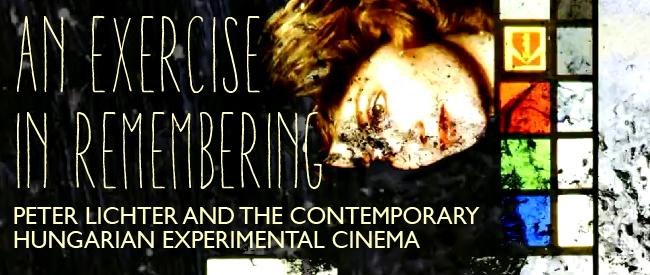
AN EXERCISE IN REMEMBERING: Péter Lichter and the Contemporary Hungarian Experimental Cinema
Dir. Various, 2002-2015
Hungary, 77 min.
Hungarian w/ English subtitles.
WEDNESDAY, JUNE 3 – 10 PM
THURSDAY, JUNE 18 – 7:30 PM
FRIDAY, JUNE 26 – 7:30 PM & 10 PM
BUY ADVANCE TICKETS HERE
“The future of Hungarian experimental film is open” – claimed Lóránd Hegyi in his 1983 review of the topic. Thirty years later the same is true, and Hungarian experimental film still exists – even if it is currently hiding. Following the elimination of creative workshops and restructuring of film theaters, museums and galleries became primary forums for experimental films, and they have been forced to share the space with video art pieces designed for this specific environment. Raymond Bellour connected the gallery installation experience with the loss of sustained concentration and defined the cinema with its specific features (isolation, darkness, strict positioning of the viewer) as the optimal environment for focused attention – somnambulism versus hypnosis.
As a result of the scarce attention new media curators and art historians have paid to the history of experimental film, Hungarian avant-garde film had to give up on the hypnotic potential of cinema, which had a great impact on the form of the films produced. Following the millennium pieces made by filmmakers (not by artists who work with film) include several surrealistic works, trance films, lyrical abstractions (Lichter’s No Signal Detected), animations, and found footage experiments (Lichter’s Rimbaud, Look Inside The Ghost Machine).
Péter Lichter is one of the few active contemporary experimental filmmakers in Hungary. Enacting visually the magic workings of remembering has long been a pet theme in filmmaking. Iconic filmmakers like Alain Resnais or Károly Makk have been preoccupied with recalling long-past events, and revealing minute and subtle linkages among them. Lichter’s films belongs to the trend defined by Marie Menken and Stan Brakhage: the lyrical film. Brakhage – whose visionary world is one of the main inspirations of Lichter’s films – is an unconcealed follower of the Freudian thinking. The most controversial parts of Freud’s scientific work – the exploration of the unconscious and the development of the body analysed from a psycho-sexual aspect – constitute the backbone of Lichter’s early films such as Light Sleep.
It is important to mention that although Lichter refers to predecessors he does not repeat them. His films gain the above-mentioned cultural and film genre reflections as well as taking the concept or corporeity to the next level by showing the results of chemical reactions (Lichter used nail polish, eye shadow, ink and milk to damage the film). Later on he screened the fractured material and recorded it with a camera. By making the material visible he revealed its body.
Hungarian experimental film has never been an isolated phenomenon and the problems it has to face are problems other countries share. To overcome the loss of its original forum but still secure the cinematic experience it needs to find a new space and remove itself from the artificially lit gallery walls. -Dorottya Szalay
Dorottya Szalay is a film theorist and historian focusing on Central and Eastern European film, and the editor of Hungarian avant-garde film forum kontracinema.com. She is currently based in Prague investigating the Czech experimental scene. The writing below was excerpted from several of her essays published in artinCINEMA – please visit artinCINEMA.com to enjoy the full articles.

NO SIGNAL DETECTED
Péter Lichter, 2013. 3 min.
“A rhythmical combat of digital and chemical decay.” Lichter recycles an excerpt from Enter the Dragon to contrast the decay of cellulose with the “malfunction” of the digital moving image. The rhythm of the film and shifts between analog and digital are dictated by the sound of Bruce Lee’s punches, kicks and screams. -DS
RIMBAUD
Péter Lichter, 2014. 20 min.
Edited from thirty reels of Super8 home videos, Rimbaud shares stories about the adventures of the rebellious rhymer in three different languages: Swedish, Arabic and Indonesian. To overcome the disturbing eclecticism of the dissonant found footage materials, Lichter used the method of plastic cutting, so the movement within the frame is carried across the cut. As a result, footage from different sources melt together and form an organic whole. -DS
PURE VIRTUAL FUNCTION
Péter Lichter, 2015. 2 min.
POLAROIDS
Péter Lichter, 2015. 13 min.
LOOK INSIDE THE GHOST MACHINE
Péter Lichter, 2012. 4 min.
LOST WORLD
Gyula Nemes, 2004. 20 min.
Gyula Nemes’s grandiose work Lost World covers ten years of the life of Kopaszi dam. By using the sound of a previous, unfinished documentary, recorded by the Dunkeszi MÁV Orchestra, as its own music, the film strengthens the historical character of the images depicting the decay. Nemes follows the slower, more subtle trend of lyrical film, carries on with the formal inventions of Marie Menken’s Notebook and exploits the method of plastic cutting to create a quiet flow of images. -DS
HOTEL TUBU
Igor and Ivan Buharov, 2002. 5 min.
Taking elements from different religious, social and artistic ideologies such as surrealism, folklorism, Buddhism to create their own universe, the Buharovs also borrow from several avant-garde trends and incorporate their elements into a grotesque and metaphysical mish-mash. The damaged images unveil the materiality of film and emphasize the self-reflexivity of avant-garde cinema while the pure, bucolic surroundings override the elitism connected to experimentalism. -DS
LITTLE APOCRYPHA NO.1
Kornél Mundruczó, 2004. 6 min.
Kornél Mundruczó is one of the leading film directors in Hungary. His latest film, White Dog, screened at Sundance. This is one of his earlier experimentals. – PL
HANNA
Péter Klausz, 2012. 7 min.
Péter Klausz is a young experimental filmmaker making camera-less films. He is a beginner in the international scene, but Hanna
